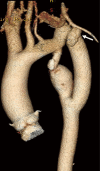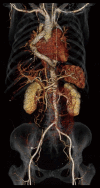Coarctation repair-redo challenges in the adults: what to do?
- PMID: 29780722
- PMCID: PMC5945897
- DOI: 10.21037/jovs.2018.04.07
Coarctation repair-redo challenges in the adults: what to do?
Abstract
Aortic coarctation is one of the most common congenital cardiac pathologies. Repair of native aortic coarctation is nowadays a common and safe procedure. However, late complications, including re-coarctation and aneurysm formation, are not uncommon. The incidence of these complications is dependent on the type of the initial operation. Both endovascular and conventional open repair play important roles in the treatment of late complications after previous coarctation repair. This article will review the incidence of late complications after coarctation repair and will discuss the treatment options for redo coarctation repair in adult patients.
Keywords: Coarctation; descending aortic repair; thoracic endovascular repair.
Conflict of interest statement
Conflicts of Interest: The authors have no conflicts of interest to declare.
Figures



References
-
- Morgagni GB. De sedibus et causis morborum. Epist XVIII 1760:6.
Publication types
LinkOut - more resources
Full Text Sources
Other Literature Sources
